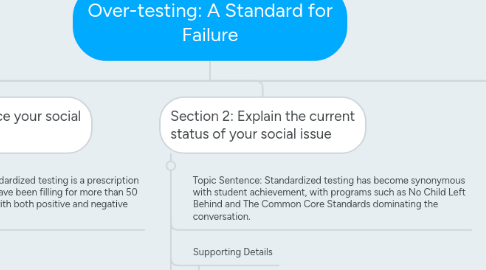
1. Introduction Paragraph
1.1. Attention Grabber 1: One hundred and eleven tests, two hundred fifty seven hours of class time devoted: Standardized tests are important for assessing student achievement, but how much is too much?
1.2. Attention Grabber 2: Unfortunately for high school student Ankur Singh, the burden of over-testing became a liability to his learning: “I felt defeated…like school [was] holding me back from reaching my true potential” (Strauss). In the wake of a seemingly perpetual onslaught of standardized tests, Singh suffered emotional distress which hindered his ability to achieve academic success.
1.3. Thesis Sentence: Standardized testing has become entrenched in modern education: in the past, it began as a response to inconsistencies in an ever-expanding public education system; today, it has become an increasingly overbearing presence in the classroom; and, in the future, key issues with the current system must be addressed to insure a positive learning experience for America’s youth.
1.4. References
1.4.1. Study says standardized testing is overwhelming nation’s public schools
1.4.2. One teen’s standardized testing horror story (and where it will lead)
1.5. Notes
1.5.1. 10.3 tests, 25.3 hours of class time in 8th grade alone
1.5.2. Appeals to pathos
1.5.3. Anecdote from an over worked student
2. Section 1: Introduce your social issue
2.1. Topic Sentence: Standardized testing is a prescription students in the U.S. have been filling for more than 50 years--and it's a pill with both positive and negative side-effects.
2.2. Supporting Details
2.2.1. The history of Standardized testing: where did it come from, and why does it exist?
2.2.2. The benefits of standardized testing
2.2.3. The problems with standardized testing
2.3. References
2.3.1. BRIEF HISTORY: Standardized Testing
2.3.2. The historical and social foundations of standardized testing
2.4. Notes
2.4.1. The first standardized tests originated in China
2.4.2. The SAT and ACT tests are the most famous
2.4.3. The "social theory of functionalism"
2.4.4. Testing leads to greater drop-out rates
2.4.5. Maintaining high expectations and accountability
3. Section 2: Explain the current status of your social issue
3.1. Topic Sentence: Standardized testing has become synonymous with student achievement, with programs such as No Child Left Behind and The Common Core Standards dominating the conversation.
3.2. Supporting Details
3.2.1. The prevalence of standardized tests
3.2.2. No Child Left Behind
3.2.3. The Common Core Standards
3.3. References
3.3.1. Testing overload in America's Schools
3.3.2. Study says standardized testing is overwhelming nation’s public schools
3.3.3. A Guide to Education and No Child Left Behind
3.3.4. 5 Tips for Explaining Common Core to Parents
3.4. Notes
3.4.1. What are the CCS?
3.4.2. What are the educator requirements for NCLB?
3.4.3. 10.3 tests, 25.3 hours of class time in 8th grade alone
4. Section 3: Outline a solution regarding your social issue
4.1. Topic Sentence: Standardized testing can become more effective if test hours are reduced, student stress is mitigated, and more power is allotted to individual teachers.
4.2. Supporting Details
4.2.1. Reducing testing hours
4.2.2. Lowering test stress
4.2.3. Increasing teacher collaboration and control
4.3. References
4.3.1. Overcoming test anxiety
4.3.2. Alleviating Students' Stress
4.3.3. Confirmed: Standardized testing has taken over our schools. But who’s to blame?
4.3.4. NEA To Congress: Less Standardized Testing, More Help, Please
4.4. Notes
4.4.1. Informing teachers on how to help students reduce test anxiety
5. Conclusion
5.1. Summary Points
5.1.1. Standardized testing is important, but flawed
5.1.2. Standardized testing currently takes up too much time and creates many unnecessary problems
5.1.3. Standardized testing can be improved by implementing to provided suggestions
5.2. Notes
5.2.1. Remember to tie in anecdote from intro
